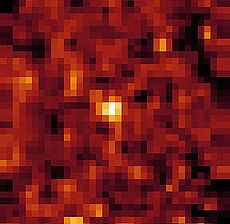Discovery date 10 January 2002 Alternative names none Discovered 10 January 2002 Argument of perihelion 293.3° | MPC designation (55565) 2002 AW197 Observation arc 6647 days (18.20 yr) Inclination 24.351° Orbits Sun | |
 | ||
Discovered by Michael E. BrownChad TrujilloEleanor F. HelinMichael HicksKenneth J. LawrenceSteven H. PravdoPalomar Observatory (675) Minor planet category Cubewano (MPC)Extended (DES) Discoverers Michael E. Brown, Steven H. Pravdo, Chad Trujillo, Kenneth J. Lawrence, Eleanor F. Helin Similar Michael E Brown discoveries, Other celestial objects | ||
55565 2002 aw197
(55565) 2002 AW197 is a classical Kuiper belt object (cubewano). Measurements with the Spitzer Space Telescope have confirmed 2002 AW197 as a probable dwarf planet, although it has not been officially classified as such by the IAU. Light-curve-amplitude analysis shows only small deviations, which suggests that 2002 AW197 is a spheroid with small albedo spots. Tancredi (2010) accepts it as a dwarf planet. Mike Brown's website lists it as a highly likely dwarf planet.
Contents
It was discovered on January 10, 2002, by Michael Brown et al. It is located near the Kuiper cliff.
Characteristics
Observations of thermal emissions by the Spitzer Space Telescope in 2007 give a diameter of 7005734000000000000♠734+116
−108 km and an albedo of 6999117000000000000♠0.117+0.04
−0.03. The newest estimate is 7005768000000000000♠768+39
−38 km
Surface
ESO analysis of spectra reveals a strong red slope and no presence of water ice (in contrast to Quaoar, also red) suggesting organic material (see comparison of colours and typical composition inferred from spectra of the TNOs).
Distance
As of 2013, it is currently 46.0 AU from the Sun. It will come to perihelion around 2078.
